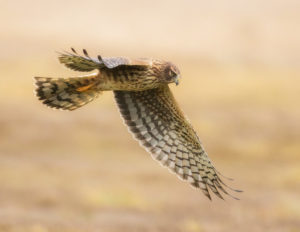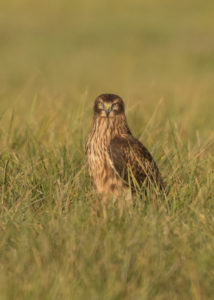 Now that fall has settled in all around us, you’re likely to encounter this eye-catching raptor in open fields or marshes, and most likely when in flight. During migration in the fall and spring, you can also see them gliding high in the sky over mountain ridges and coastlines.
Now that fall has settled in all around us, you’re likely to encounter this eye-catching raptor in open fields or marshes, and most likely when in flight. During migration in the fall and spring, you can also see them gliding high in the sky over mountain ridges and coastlines.
The Northern Harrier is an impressive medium-sized raptor with a distinctive owl-like face, long tail and wings, and white rump. And, much like an owl (and unlike most other hawks), it relies on its keen hearing, as well as its vision, to locate prey as it flies low and slow over fields and open country, going back and forth over fields and marshes as it watches and listens, wings held in a V-shape. To locate prey in dense cover, it may hover low in an attempt to drive prey out into the open.
The Northern Harrier’s diet varies, depending on location and season. During the breeding season it’ll eat small mammals, reptiles, amphibians and birds. In winter, it feeds mostly on meadow voles, but also likes mice, shrews and rabbits, even other birds – from songbirds up to flickers,  doves, and even small ducks!
doves, and even small ducks!
During breeding, the male performs a very cool and elaborate aerobatic performance to attract the attention of females and announce its territory, sometimes covering more than half a mile; the motion mimics that of a roller coaster. Most males have one or two mates at a time, but may even have up to five when food is abundant. Wow!
Northern Harriers commonly breed in large, undisturbed wetlands and grasslands with thick vegetation, where their nests can be concealed. Western populations tend to breed in dry upland areas, and northeastern and midwestern birds commonly breed in wetlands. During winter they use a range of low-vegetation habitats, such as deserts, coastal sand dunes, pastures, dry plains, grasslands, estuaries, open flood plains, and marshes.
During migration and in winter, harriers typically move to the south, away from areas that receive heavy snow, searching for open habitats similar to their breeding grounds.
Either the male or the female chooses the nest site, which is at ground level and usually in a dense jumble of vegetation, like willows, grasses, sedges, reeds, bulrushes and cattails.
Both the male and female contribute to building their nest – they both bring in nest material, but the female arranges it just so to form the nest. The nest platform is made of plants such as cattails, alders, and willows, and the inner nest consists mainly of grasses, sedges and rushes. The outer nest can be 1 – 1.5 feet wide and several inches high, and the inner next is about 10 inches wide and a few inches deep. Not surprisingly, it can take one or two weeks to finish the nest.
Although Northern Harriers don’t protect broad territories, both male and female zealously defend their nest. Nesting females typically chases away other females, and males chase other males.
The female will typically produce 4-6 eggs, but sometimes as few as 2 and as many as 7. She also incubates the eggs, typically for 30-32 days, and remains with her young most of time at first. The male’s job is to bring food to the female, which she then feeds to the young. The young may wander a short distance from the nest after a week or so, but come back to the nest when it’s time to eat. They’re able to fly after about a month. Juveniles play and sharpen their hunting skills by pouncing on motionless objects like vole-sized corncobs.
Cool Facts:
Northern Harriers are the most owl-like of hawks, though they’re not related to owls. They rely on hearing as well as vision to capture prey.
Northern Harriers hunt mostly small mammals and birds, but are capable of taking down bigger prey, like rabbits and ducks. They sometimes subdue larger animals by drowning them.
Northern Harrier fossils dating from 11,000 to 40,000 years ago have been unearthed in northern Mexico.
The oldest Northern Harrier on record was a female, and at least 15 years, 4 months old when she was captured and released in 2001 by a bird bander in Quebec.
Photo Credit: Angie Vogel